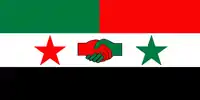Safe Zone (Syria)
Safe Zones, more commonly known as "de-escalation zones"[1][2] were four ceasefire areas established in Syria in order to halt the intense fighting between Syrian government forces and armed rebels in western and southern Syria. The framework for the de-escalation zones were agreed on as a result of the Astana talks between Russia, Iran and Turkey, in May 2017 while the final demarcation of the areas were completed in June 2017. The de-escalation zones agreement was set to expire in 6 months, with the possibility of continued renewal.
| Population 21 ±.5: Displaced 6 ±.5, Refugee 5.5 ±.5, Casualty 0.5 ±.1 (millions) | |
| Syrian refugees | |
| By country | Turkey, Lebanon, Jordan, Egypt |
| Settlements | Camps: (Jordan) |
| Displaced Syrians | |
| Casualties of the war | |
| Crimes | Human rights violations, massacres, rape |
| Return of refugees · Refugees as weapons · Prosecution of war criminals | |
| Part of a series on the Syrian Civil War |
| Syrian peace process |
|---|
 |
The de-escalation zones were set up in the greater Idlib region (including parts of Latakia and Aleppo under armed rebel control), the Rastan pocket in the Homs governorate, eastern Ghouta, including the Damascus countryside, and southern Syria (parts of Daraa and Quinetra governorates under insurgent control). The de-escalation zones notably excluded the American-controlled at-Tanf pocket, the areas controlled by the Syrian Democratic Forces in north and eastern Syria and the Turkish-controlled zones in the north.
The de-escalation zones are demarcated by the presence of Turkish, Iranian and Russian observation posts on the opposing sides the line separating governments forces from armed rebel forces. It was reported that Russian military police would work with Turkish military forces in the de-escalation zones and not let any Syrian Arab Army formations enter these areas in order to avoid any incitement which could turn into escalation.
As of January 1, 2019, the de-escalation zones in southern Syria, Damascus and Homs have been abolished after offensives conducted by the Syrian Arab Army on three occasions, which resulted in most of the armed rebels reconciling with the government and a sizeable minority taking the government-sanctioned busses to the greater Idlib region.
References
- Wintour, Patrick, Diplomatic editor (May 9, 2017). "Syria safe zones on hold amid concern over how deal will be enforced". The Guardian – via www.theguardian.com.
- "Here's why Syria's "de-escalation zones" aren't "safe zones"".